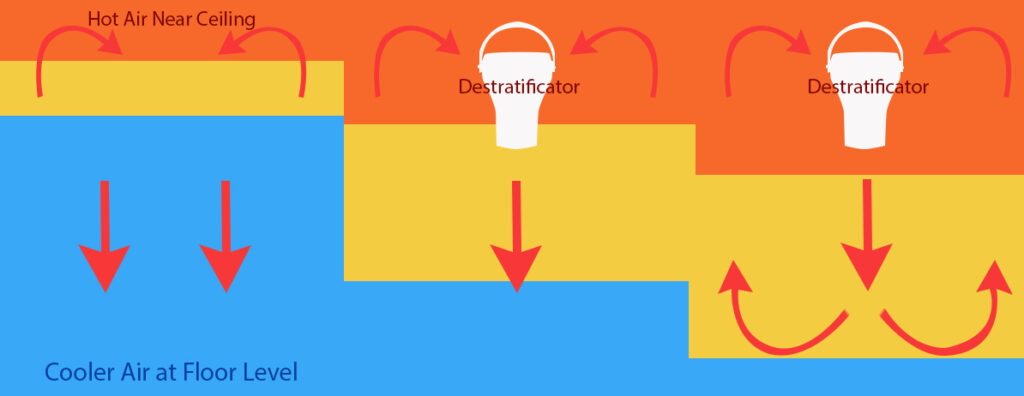What is Destratification

Destratification, in the context of commercial and industrial scenarios, refers to the process of reducing temperature stratification within a space by mixing and circulating the air effectively. Here are the benefits of destratification:
1. **Energy Efficiency**: Destratification improves energy efficiency by reducing the temperature differential between the floor and ceiling of a space. In buildings with high ceilings, warm air tends to rise and accumulate near the ceiling, while the lower areas remain cooler. By using destratification methods such as ceiling fans or specialized destratification fans, the warm air is pushed down to the occupied zone, resulting in more even temperature distribution. This reduces the load on heating systems, enabling energy savings and cost reduction.
2. **Improved Comfort**: Destratification helps create a more comfortable environment for occupants. By eliminating hot and cold spots within a space, it ensures a consistent and uniform temperature throughout, promoting occupant comfort. This is particularly important in commercial and industrial settings where maintaining optimal working conditions is essential for productivity and employee well-being.
3. **HVAC System Optimization**: Destratification can enhance the performance of HVAC (Heating, Ventilation, and Air Conditioning) systems. By redistributing warm air from the ceiling to the occupied zone, the heating system can operate more efficiently, as it does not have to work as hard to maintain a comfortable temperature. This can result in extended equipment lifespan, reduced maintenance costs, and improved overall HVAC system performance.
4. **Condensation Prevention**: In industrial settings with processes that generate humidity or involve temperature variations, destratification helps prevent condensation. By minimizing temperature differences, destratification reduces the likelihood of moisture buildup on surfaces, which can lead to corrosion, mold growth, and equipment damage. This is particularly crucial in areas such as warehouses, manufacturing facilities, or food processing plants where condensation can have detrimental effects.
5. **Energy Savings**: By promoting efficient air circulation and temperature equalization, destratification reduces the need for additional heating or cooling energy. This directly translates into energy savings and lower utility bills. In large commercial or industrial spaces where heating or cooling demands are substantial, implementing destratification strategies can lead to significant cost reductions over time.
In summary, destratification in commercial and industrial scenarios offers multiple benefits, including energy efficiency, improved comfort, HVAC system optimization, prevention of condensation-related issues, and energy savings. By addressing temperature stratification and promoting optimal air circulation, destratification contributes to a more sustainable, comfortable, and cost-effective operational environment.